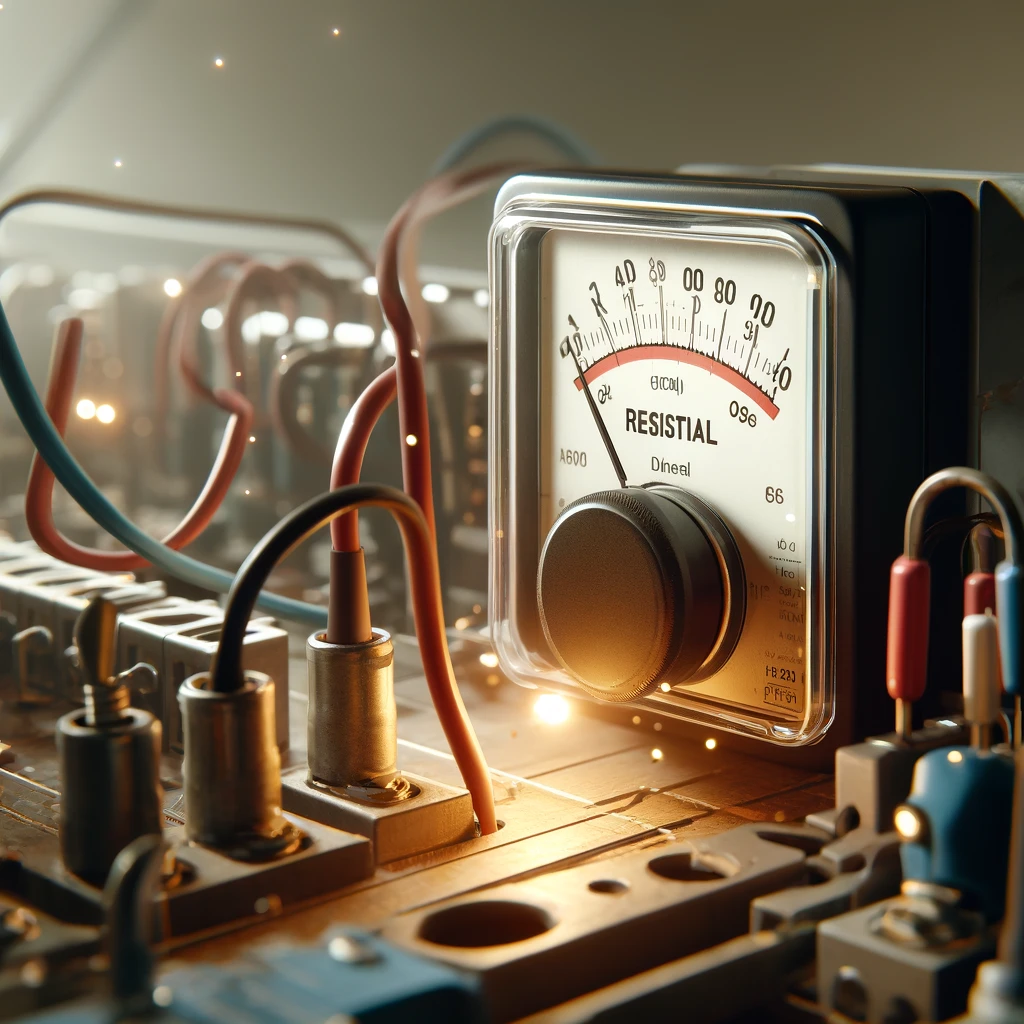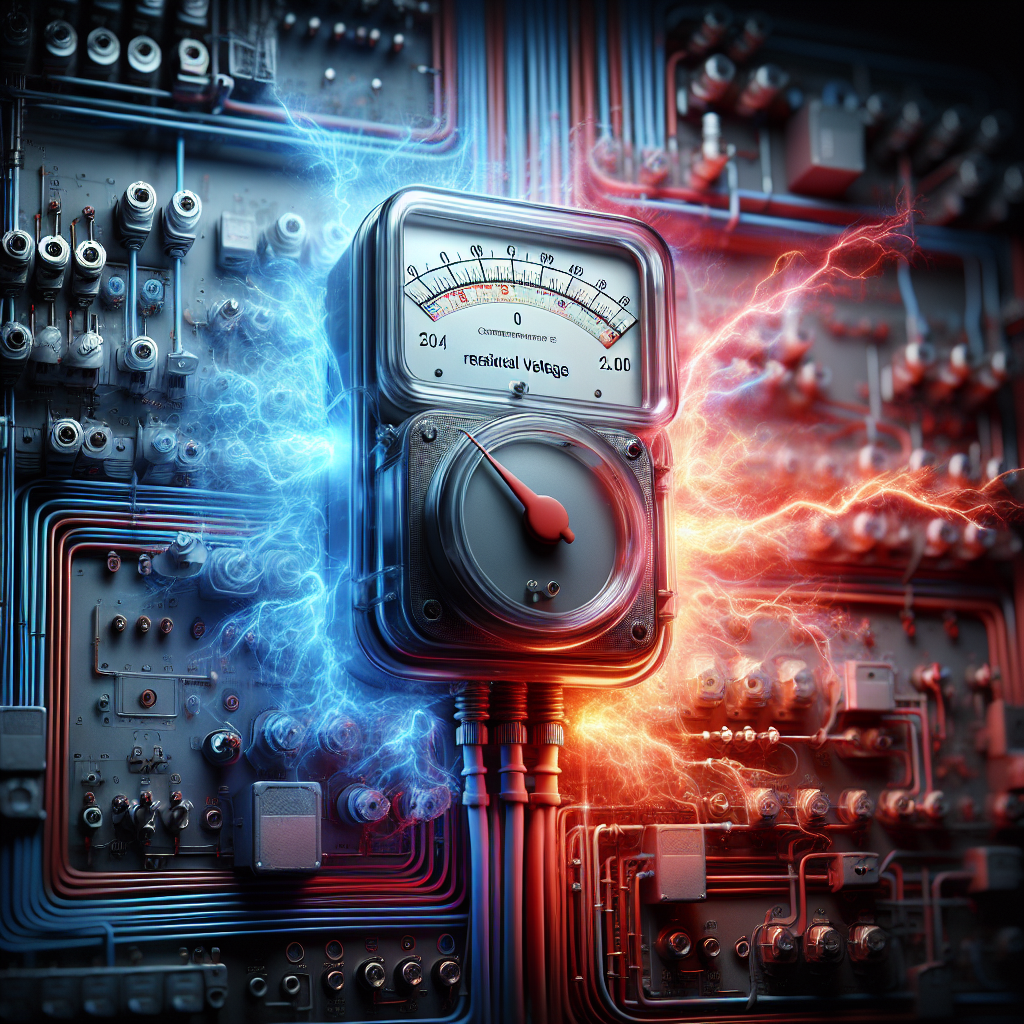The Exciting World of Residual Voltage
Take a guess – when you flip the switch off on your electronic devices, do you think the electrical charge is instantly zero?
Fascinatingly, it’s not.
Residual voltage doesn’t just fizzle out immediately. As intriguing as it sounds, residual voltage dies down gradually in a fascinating process known as the “adjustment time”. It’s not the high-speed chase you might imagine, instead, this stage can take several milliseconds for the residual voltage to drop to a safe level.
The duration of this residual voltage in action can vary depending on several factors, such as the type of device, the amount of stored energy, ambient temperature, and other conditions.
Hang tight to venture into the less-explored corners of residual voltage in various generators. We’ll also decipher the dangers of surging residual voltage and the role of grounding in managing it.
Ready for our electrifying article ahead?

Table of Contents
The Truth About Residual Voltage Duration
Defining Residual Voltage
Let’s cut to the chase.
So, what exactly is this ‘Residual Voltage’?
In layman’s terms, residual voltage is the leftover or “residual” electrical charge that remains in an electronic device or system even after it’s been turned off or disconnected from a power source.
Understanding the Adjustment Time of Residual Voltage
Now that you’ve got your basic definition in hand, let’s amp up the knowledge about adjustment time. Adjustment time, often measured in milliseconds, refers to the time it takes for residual voltage to decrease to a safe level. This is crucial in protecting workers from electric shock during maintenance, repairs, and other construction tasks.
The Factors Influencing Residual Voltage Duration
While we now know what residual voltage is and its potential dangers, understanding the factors that influence its duration is key. The time that residual voltage can last is affected by numerous elements such as:
- The type of equipment and its insulation properties
- The amount of stored energy in the system
- The ambient temperature and humidity conditions
Determining Residual Voltage Duration
For those tech-savvy guys, this part’s for you. Measuring the residual voltage duration, often known as “decay time”, reveals interesting insights:
| Measurement Tools | Application |
|---|---|
| Voltage Meter | Measure precise voltage levels in a circuit |
| Oscilloscope | Determine decay rate over time |
A Word of Caution
A critical approach should be applied when examining residual voltage durations as the safety stakes are high. Always ensure safety procedures are meticulously followed to avoid electric shock hazards!
Practical Tips to Manage Residual Voltage
Here’s the practical side of things: a few straightforward tips for handling residual voltage in construction work:
- The use of proper protective equipment
- Implementation of power decay time into safety protocols
- Regular maintenance and checks on electronic devices
- Use of accurate measuring tools for voltage

Residual Voltage In Generators
The Residual Voltage in Different Generators
We’ve laid out the ground works about residual voltage. Now let’s fuel the discussion further by exploring the concept of residual voltage in different generators. Wielded correctly, this information can help keep workplace accidents to a minimum.
Generators, in both industrial and home settings, can maintain a residual voltage. This leftover charge may vary depending on make, design, and age of the generator. However, the general rule of thumb is, larger and more powerful generators will maintain higher residual voltage levels, and conversely, smaller, less powerful ones will have lower residual levels.
Insights About Residual Voltage in Generators
Glimpse the panorama of residual voltage in generators as influenced by factors such as load types, starting method, generator rotational speed and magnetizing method.
- Load type: Generators handling reactive loads, like motors, tend to maintain higher residual voltage.
- Starting method: The method used to start the generator can influence the initial residual voltage. Some methods leave a more significant initial residual voltage, which decreases with the passage of time.
- Rotational speed: Higher rotational speeds can increase the residual voltage.
- Magnetizing method: The method used for magnetizing the generator’s rotor has a significant impact on the residual voltage.
The Role of Residual Voltage in Generator Operation
This may surprise you, but the residual voltage of a generator plays a critical role in its operation. A generator uses residual voltage to magnetize the core of the generator during the initial start-up, creating an electromagnetic field crucial for its function.
So, the next time you switch on your generator, remember, it’s the residual voltage stepping up to the plate to kick off the action!
Implications of Low or No Residual Voltage
Imagine this: trying to start a generator but it fails to produce any power. It could be a case of low or no residual voltage which implies either the generator has been at rest for a prolonged period or it has a faulty part.
Residual Voltage and Generator Health
As much as residual voltage correlates to the operation of a generator, it also reflects the health of the generator. Regularly testing for residual voltage is an excellent practice. It can help reveal issues related to the generator’s windings, like insulation degradation.
| Health Indicator | Description |
|---|---|
| High Residual Voltage | Generators with excessively high residual voltage could be indicative of a fault or short circuit in the windings |
| Low Residual Voltage | A lower than usual residual voltage can suggest the generator has been idle for an extended period or there is a degradation in the generator’s windings |
A Proactive Stance on Generator Health
Stay ahead of the game! With regular generator health checks, you can prevent potential problems before they escalate into major issues. After all, a stitch in time save nine!
And remember, knowledge is power when it comes to dealing with residuals. The more you’re familiar with the personality of your generator’s residual voltage, the better prepared you are to keep it in stellar condition.

Hold Onto Your Speedometers: Let’s Talk Surging Residual Voltage
The Mystery of Surging Residual Voltage
Alright, let’s dive into the deep end.
We’ve unpacked the intricacies of residual voltage, gotten technical with adjustment time and duration – now let’s swing the doors wide to give you a shockingly vivid description of the surging residual voltage.
Surging residual voltage occurs when there’s a sudden increase in the amount of voltage in an electronic device or system. Just like ocean waves at high tide, this surge can cause the voltage to spike above the normal level and then recede back.
The Wild Rides of Surging Residual Voltage
Wait a minute! What could cause such surges in the first place? The culprits are often sudden high energy events, like lightning strikes, power outages, or electrical equipment switching on and off in the power supply system. These electrical earthquakes can cause the voltage spikes we dub as “surging residual voltage”.
Impact of Surging Residual Voltage
Interestingly, and somewhat ominously, these surges can potentially damage your electronic equipment. They might cause the device to malfunction, degrade faster, or in the wackiest of circumstances, make it go “Poof!” in a flash of smoke.
| Surges Impact | Description |
|---|---|
| Malfunction | Surges can cause the device to function improperly, for example, randomly switching on or off, making unusual noises, or displaying error messages. |
| Accelerated Degradation | Continuous surges can cause the device’s components to degrade faster, hence reducing its lifespan. |
| Damage | In severe cases, surges can cause intense heat, melting the insulation and causing sparks that lead to fire hazards. |
Tackling the Surges
Look, the beauty of knowledge is that it leads to solutions, not fear, right? You’ve gotten acquainted with the beast. Now, let’s equip you with the best tools to tackle these surging residual voltages.
- SPDs: Surge Protection Devices are your best bet against surges. These devices cut off or reduce excessive voltage to prevent equipment damage.
- Power Conditioners: These clever devices not only protect against surges but also maintain voltage at an optimal level.
- Voltage Stabilizers: When your power supply is more like a roller coaster ride than a smooth highway, voltage stabilizers help to maintain an even keel.

The Role of Grounding in Controlling Residual Voltage
The Power of Grounding
Let’s zoom into another fascinating angle of managing residual voltage – grounding. Grounding is the process of connecting an electrical system or device to the earth. It’s a key factor in dealing with residual voltage and increasing the safety of electrical systems.
Why Grounding Matters
Grounding directs any residual voltage into the earth, thereby significantly reducing the potential for electric shock. In the event of a fault or power surge, grounding provides an alternative path for the electric current, which boosts safety and prevents damage to electrical devices.
Grounding and Residual Voltage: The Connection
Grounding is particularly effective at managing residual voltage in SPDs. The residual voltage is substantially lower in properly grounded systems. This goes a long way in protecting devices and personnel from electric shock.
Best Grounding Practices
To benefit fully from grounding, you need to make sure it’s done right. Here are some best practices:
- Grounding should be carried out by a qualified electrician.
- Use specified grounding equipment, such as grounding rods and wiring.
- The grounding connection should be regularly inspected and maintained.
- Avoid ground loops that can cause interference or noise in electric circuits.
Master Tools to Monitor Residual Voltage
The Benefits of Monitoring
Old Ben Franklin had it right when he said, “An ounce of prevention is worth a pound of cure.” In the exciting world of residual voltage, being proactive can definitely save you a ton of headaches, not to mention costly repair bills!
Next-Level Monitoring Tools
The world’s gone digital and so have monitoring tools. Next-gen digital multimeters and clamp meters allow you to monitor residual voltage with laser-like precision. Paired with software-driven data analysis, you’re looking at comprehensive, almost-real-time insights into your electronic devices and systems.
- Digital Multimeters: These devices give you a timely heads-up on any irregularities in your electrical system.
- Clamp Meters: If you’re dealing with high voltage systems or just prefer a non-contact method, clamp meters come to the rescue.
- Data Analysis Software: Complementing these tools, data analysis software provides a platform to collect, organize and analyze the information to help identify trends and correlations, which can help predict potential issues.
The Bottom Line: It’s Better to Know!
Being in the know about residual voltage and how to manage it can make a world of difference in how you interact with and maintain your electrical devices and systems. It’s not just about minimizing risk, but also about extending the life of your equipment and boosting productivity.

Residual Voltage in Transistors
Decoding Residual Voltage in Transistors
Let’s switch tracks to something a smidge more microscopic yet equally electrifying, the residual voltage found in transistors. Transistors, the unacknowledged workhorses of the electronic world, are not spared from the phenomenon of residual voltage.
In the context of a transistor, this ‘residual’ might refer to the voltage remaining across the transistor’s junction even when the device itself is not actively conducting current.
Transistor Characteristics and Residual Voltage
Oh, yes! Just like individual humans, transistors have their unique traits. In our case, these are typically termed as ‘characteristics’. And believe me, they play as much of an engaging role in mediating the residual voltage as they do in controlling the functional behavior of the transistor.
Rundown on Transistor Characteristics
From transfer characteristics, output characteristics, to the more inherent ones like cut-off voltage, saturation voltage, these features interpret different functional aspects of a transistor. And yes, you’re right, these characteristics have a proportionate say in determining the residual voltage.
- Transfer characteristics: The correlation between output and input currents for a characteristic biasing defines this trait in the transistor. This relationship influences the residual voltage.
- Output characteristics: While it technically refers to the relationship between output current and voltage for a specific input current, it indirectly plays a part in shaping the residual voltage scene.
- Intrinsic transistor characteristics: It’s not just about cut-off voltage and saturation voltage. Any intrinsic characteristic of the transistor, be it base width, doping levels, or even the material of the transistor itself can impart subtle but significant influences on the residual voltage.
Residual Voltage: Influence on Transistor Performance
Here’s a newsflash! Residual voltage doesn’t just idle about in a transistor; it carries a potent influence on the performance of the device. Its repercussions stretch from the operating speed of the transistor to energy efficiency, junction temperature and even the longevity of the transistor.
Illustrating the Impact
Visualize this fact using a commonly witnessed scenario in silicon-based transistors. Silicon transistors are generally doped to contribute to a specific cut-off voltage. Now, if there’s a significant residual voltage persisting in the semiconductor device, it could alter the depletion region, thereby affecting the cut-off voltage of the transistor. This can further hamper the overall functionality of the device. And therein lies the ripple effect!
Overcoming Residual Voltage Triggers in Transistors
Alright, now that you’re well aware of the challenges, let’s tread ahead into the solution zone. Fact is, there’s a vast array of strategies adopted to keep residual voltage under check in transistors:
- Optimizing the doping levels in the transistor to ensure an ideal cut-off voltage.
- Ensuring correct biasing of the transistor to avoid residual voltage build-up.
- Designing transistor circuits with built-in protection against high voltage or current spikes.
- Monitoring the heat levels and maintaining efficient thermal management.

Reading Residual Voltage Across a Transistor
The Art of Voltage Reading
In the face of all this knowledge, an accessible question would naturally be – how does one go about reading this residual voltage in a transistor? Hold that thought. Let’s walk you through the basics of using one of the most esteemed tools in electronics – the Voltmeter.
Transistor, Meet Voltmeter
Here’s where things get tactile! Say hello to your voltmeter, a crucial device that helps reveal the secrets of a transistor’s residual voltage. These digital devices measure the voltage or voltage drop across two points in an electrical circuit.
Mastering the Voltmeter
Navigating a voltmeter isn’t as daunting as it may seem. Essentially, all you need to do is:
- Select the appropriate voltage function on the dial.
- Connect the test leads to the transistor terminals.
- Read the value displayed on the screen. (In most voltmeters, the red test lead is for positive, and the black one for negative).
The Voltmeter’s Tale: Understanding the Gauge
So, you’ve got your reading. But what does it mean? If the voltage reading is close to zero, it indicates that the transistor is off, implying no current flow. Conversely, a substantial reading informs you that the transistor is in an ‘on’ state. Anything in between becomes a tale of residual voltages!
Voltmeter Reading: Safety Measure or Troubleshooting Cue?
Well, truthfully, it’s both! A voltmeter reading allows you to ensure that your transistor is safe for manipulation or replacement. Additionally, the reading also provides critical insight into the performance of your transistor if you’re tracking a potential issue.
Expert Tools: Beyond the Voltmeter
Dare to dig a little deeper? Over and above the humble voltmeter, there are more advanced tools such as an oscilloscope or logic analyzer to visualize and monitor the precise behavior of residual voltage in a transistor.
- Oscilloscope: An oscilloscope is a laboratory instrument that allows observation of constantly varying signal voltages. It is an enhanced visualization tool for tracking residual voltage over time.
- Logic analyzer: These complex devices are used for capturing and displaying multiple signals from a digital system or digital circuit. They offer the apogee of precision and opacity while dealing with digital transistors.
Voltage Reading: Paving the Path Towards Safe Interactions
In the aftermath of reading residual voltage across a transistor, you’re not just monitoring a device’s status. It’s a responsible stride towards ensuring safe and effective interactions with electronic circuits.

Shutting Down the Power: The Final Word on Residual Voltage
We’ve been zapping around residual voltage discussions, spitting out definitions and diving into key factors that influence its duration.
But remember, it all boils down to safety and precaution. As such, keen attention should be paid to the characteristics of equipment, the role the environment plays, and correct measurement methods.
When it comes to putting theory into practice, employing a mixture of protective equipment, precision tools, and regular maintenance checks is vital. Above all, making the residual voltage adjustment time a core component of safety protocols can vastly improve safety in the construction industry.
At the end of the day, we are all ultimately responsible for creating a safe, electrical hazard-free environment.
So let’s ensure a charge-full experience in construction, without the shock!






